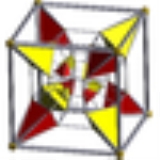
Runcinated tesseract
Encyclopedia
Tesseract Tesseract In geometry, the tesseract, also called an 8-cell or regular octachoron or cubic prism, is the four-dimensional analog of the cube. The tesseract is to the cube as the cube is to the square. Just as the surface of the cube consists of 6 square faces, the hypersurface of the tesseract consists of 8... |
Runcinated tesseract (Runcinated 16-cell) |
16-cell 16-cell In four dimensional geometry, a 16-cell or hexadecachoron is a regular convex 4-polytope. It is one of the six regular convex 4-polytopes first described by the Swiss mathematician Ludwig Schläfli in the mid-19th century.... |
Runcitruncated tesseract (Runcicantellated 16-cell) |
Runcitruncated 16-cell (Runcicantellated tesseract) |
Omnitruncated tesseract (Omnitruncated 16-cell) |
| Orthogonal projections in BC4 Coxeter plane | ||
|---|---|---|
In four-dimensional geometry
Geometry
Geometry arose as the field of knowledge dealing with spatial relationships. Geometry was one of the two fields of pre-modern mathematics, the other being the study of numbers ....
, a runcinated tesseract (or runcinated 16-cell) is a convex uniform polychoron
Uniform polychoron
In geometry, a uniform polychoron is a polychoron or 4-polytope which is vertex-transitive and whose cells are uniform polyhedra....
, being a runcination
Runcination
In geometry, runcination is an operation that cuts a regular polytope simultaneously along the faces, edges and vertices, creating new facets in place of the original face, edge, and vertex centers....
(a 3rd order truncation) of the regular tesseract
Tesseract
In geometry, the tesseract, also called an 8-cell or regular octachoron or cubic prism, is the four-dimensional analog of the cube. The tesseract is to the cube as the cube is to the square. Just as the surface of the cube consists of 6 square faces, the hypersurface of the tesseract consists of 8...
.
There are 4 degrees of runcinations of the tesseract including with permutations truncations and cantellations.
Runcinated tesseract
| Runcinated tesseract | ||
 Schlegel diagram with 16 tetrahedra |
||
| Type | Uniform polychoron Uniform polychoron In geometry, a uniform polychoron is a polychoron or 4-polytope which is vertex-transitive and whose cells are uniform polyhedra.... |
|
| Schläfli symbol | t0,3{4,3,3} | |
| Coxeter-Dynkin diagram Coxeter-Dynkin diagram In geometry, a Coxeter–Dynkin diagram is a graph with numerically labeled edges representing the spatial relations between a collection of mirrors... s |
||
| Cells | 80 | 16 3.3.3 Tetrahedron In geometry, a tetrahedron is a polyhedron composed of four triangular faces, three of which meet at each vertex. A regular tetrahedron is one in which the four triangles are regular, or "equilateral", and is one of the Platonic solids...  32 3.4.4 Triangular prism In geometry, a triangular prism is a three-sided prism; it is a polyhedron made of a triangular base, a translated copy, and 3 faces joining corresponding sides....  32 4.4.4 Cube In geometry, a cube is a three-dimensional solid object bounded by six square faces, facets or sides, with three meeting at each vertex. The cube can also be called a regular hexahedron and is one of the five Platonic solids. It is a special kind of square prism, of rectangular parallelepiped and...  |
| Faces | 208 | 64 {3} Triangle A triangle is one of the basic shapes of geometry: a polygon with three corners or vertices and three sides or edges which are line segments. A triangle with vertices A, B, and C is denoted .... 144 {4} Square (geometry) In geometry, a square is a regular quadrilateral. This means that it has four equal sides and four equal angles... |
| Edges | 192 | |
| Vertices | 64 | |
| Vertex figure Vertex figure In geometry a vertex figure is, broadly speaking, the figure exposed when a corner of a polyhedron or polytope is sliced off.-Definitions - theme and variations:... |
 Equilateral-triangular antipodium |
|
| Symmetry group Symmetry group The symmetry group of an object is the group of all isometries under which it is invariant with composition as the operation... |
[3,3,4] | |
| Properties | convex Convex polytope A convex polytope is a special case of a polytope, having the additional property that it is also a convex set of points in the n-dimensional space Rn... |
|
| Uniform index | 14 Cantellated tesseract In four-dimensional geometry, a cantellated tesseract is a convex uniform polychoron, being a cantellation of the regular tesseract.There are four degrees of cantellations of the tesseract including with permutations truncations... 15 16 |
|
The runcinated tesseract has 16 tetrahedra
Tetrahedron
In geometry, a tetrahedron is a polyhedron composed of four triangular faces, three of which meet at each vertex. A regular tetrahedron is one in which the four triangles are regular, or "equilateral", and is one of the Platonic solids...
, 32 cube
Cube
In geometry, a cube is a three-dimensional solid object bounded by six square faces, facets or sides, with three meeting at each vertex. The cube can also be called a regular hexahedron and is one of the five Platonic solids. It is a special kind of square prism, of rectangular parallelepiped and...
s, and 32 triangular prism
Triangular prism
In geometry, a triangular prism is a three-sided prism; it is a polyhedron made of a triangular base, a translated copy, and 3 faces joining corresponding sides....
s. Each vertex is shared by 4 cubes, 3 triangular prisms and one tetrahedron.
Construction
The runcinated tesseract may be constructed by expanding the cells of a tesseractTesseract
In geometry, the tesseract, also called an 8-cell or regular octachoron or cubic prism, is the four-dimensional analog of the cube. The tesseract is to the cube as the cube is to the square. Just as the surface of the cube consists of 6 square faces, the hypersurface of the tesseract consists of 8...
radially, and filling in the gaps with tetrahedra (vertex figures), cubes (face prisms), and triangular prisms (edge figures). The same process applied to a 16-cell
16-cell
In four dimensional geometry, a 16-cell or hexadecachoron is a regular convex 4-polytope. It is one of the six regular convex 4-polytopes first described by the Swiss mathematician Ludwig Schläfli in the mid-19th century....
also yields the same figure.
Cartesian coordinates
The Cartesian coordinates of the vertices of the runcinated tesseract with edge length 2 are all permutations of:
Images
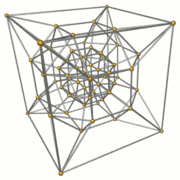 Wireframe |
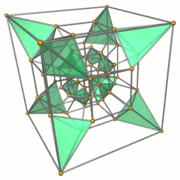 Wireframe with 16 tetrahedra Tetrahedron In geometry, a tetrahedron is a polyhedron composed of four triangular faces, three of which meet at each vertex. A regular tetrahedron is one in which the four triangles are regular, or "equilateral", and is one of the Platonic solids... . |
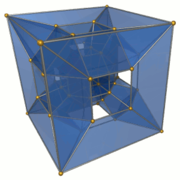 Wireframe with 32 triangular prism Triangular prism In geometry, a triangular prism is a three-sided prism; it is a polyhedron made of a triangular base, a translated copy, and 3 faces joining corresponding sides.... s. |
Structure
Eight of the cubical cells are connected to the other 24 cubical cells via all 6 square faces. The other 24 cubical cells are connected to the former 8 cells via only two opposite square faces; the remaining 4 faces are connected to the triangular prisms. The triangular prisms are connected to the tetrahedra via their triangular faces.Projections
The cube-first orthographic projectionOrthographic projection
Orthographic projection is a means of representing a three-dimensional object in two dimensions. It is a form of parallel projection, where all the projection lines are orthogonal to the projection plane, resulting in every plane of the scene appearing in affine transformation on the viewing surface...
of the runcinated tesseract into 3-dimensional space has a (small) rhombicuboctahedral
Rhombicuboctahedron
In geometry, the rhombicuboctahedron, or small rhombicuboctahedron, is an Archimedean solid with eight triangular and eighteen square faces. There are 24 identical vertices, with one triangle and three squares meeting at each. Note that six of the squares only share vertices with the triangles...
envelope. The images of its cells are laid out within this envelope as follows:
- The nearest and farthest cube from the 4d viewpoint projects to a cubical volume in the center of the envelope.
- Six cuboidal volumes connect this central cube to the 6 axial square faces of the rhombicuboctahedron. These are the images of 12 of the cubical cells (each pair of cubes share an image).
- The 18 square faces of the envelope are the images of the other cubical cells.
- The 12 wedge-shaped volumes connecting the edges of the central cube to the non-axial square faces of the envelope are the images of 24 of the triangular prisms (a pair of cells per image).
- The 8 triangular faces of the envelope are the images of the remaining 8 triangular prisms.
- Finally, the 8 tetrahedral volumes connecting the vertices of the central cube to the triangular faces of the envelope are the images of the 16 tetrahedra (again, a pair of cells per image).
This layout of cells in projection is analogous to the layout of the faces of the (small) rhombicuboctahedron
Rhombicuboctahedron
In geometry, the rhombicuboctahedron, or small rhombicuboctahedron, is an Archimedean solid with eight triangular and eighteen square faces. There are 24 identical vertices, with one triangle and three squares meeting at each. Note that six of the squares only share vertices with the triangles...
under projection to 2 dimensions. The rhombicuboctahedron is also constructed from the cube or the octahedron
Octahedron
In geometry, an octahedron is a polyhedron with eight faces. A regular octahedron is a Platonic solid composed of eight equilateral triangles, four of which meet at each vertex....
in an analogous way to the runcinated tesseract. Hence, the runcinated tesseract may be thought of as the 4-dimensional analogue of the rhombicuboctahedron.
Runcitruncated tesseract
| Runcitruncated tesseract | ||
 Schlegel diagram centered on a truncated cube, with cuboctahedral cells shown |
||
| Type | Uniform polychoron Uniform polychoron In geometry, a uniform polychoron is a polychoron or 4-polytope which is vertex-transitive and whose cells are uniform polyhedra.... |
|
| Schläfli symbol | t0,1,3{4,3,3} | |
| Coxeter-Dynkin diagram Coxeter-Dynkin diagram In geometry, a Coxeter–Dynkin diagram is a graph with numerically labeled edges representing the spatial relations between a collection of mirrors... s |
||
| Cells | 80 | 8 3.4.4 Truncated cube In geometry, the truncated cube, or truncated hexahedron, is an Archimedean solid. It has 14 regular faces , 36 edges, and 24 vertices....  16 3.4.3.4 Cuboctahedron In geometry, a cuboctahedron is a polyhedron with eight triangular faces and six square faces. A cuboctahedron has 12 identical vertices, with two triangles and two squares meeting at each, and 24 identical edges, each separating a triangle from a square. As such it is a quasiregular polyhedron,...  24 4.4.8 Octagonal prism In geometry, the octagonal prism is the sixth in an infinite set of prisms, formed by square sides and two regular octagon caps.If faces are all regular, it is a semiregular polyhedron.- Use :...  32 3.4.4 Triangular prism In geometry, a triangular prism is a three-sided prism; it is a polyhedron made of a triangular base, a translated copy, and 3 faces joining corresponding sides....  |
| Faces | 368 | 128 {3} Triangle A triangle is one of the basic shapes of geometry: a polygon with three corners or vertices and three sides or edges which are line segments. A triangle with vertices A, B, and C is denoted .... 192 {4} Square (geometry) In geometry, a square is a regular quadrilateral. This means that it has four equal sides and four equal angles... 48 {8} |
| Edges | 480 | |
| Vertices | 192 | |
| Vertex figure Vertex figure In geometry a vertex figure is, broadly speaking, the figure exposed when a corner of a polyhedron or polytope is sliced off.-Definitions - theme and variations:... |
 Rectangular pyramid |
|
| Symmetry group Coxeter group In mathematics, a Coxeter group, named after H.S.M. Coxeter, is an abstract group that admits a formal description in terms of mirror symmetries. Indeed, the finite Coxeter groups are precisely the finite Euclidean reflection groups; the symmetry groups of regular polyhedra are an example... |
B4, [3,3,4] | |
| Properties | convex Convex polytope A convex polytope is a special case of a polytope, having the additional property that it is also a convex set of points in the n-dimensional space Rn... |
|
| Uniform index | 18 19 20 | |
The runcitruncated tesseract is bounded by 80 cells: 8 truncated cube
Truncated cube
In geometry, the truncated cube, or truncated hexahedron, is an Archimedean solid. It has 14 regular faces , 36 edges, and 24 vertices....
s, 16 cuboctahedra
Cuboctahedron
In geometry, a cuboctahedron is a polyhedron with eight triangular faces and six square faces. A cuboctahedron has 12 identical vertices, with two triangles and two squares meeting at each, and 24 identical edges, each separating a triangle from a square. As such it is a quasiregular polyhedron,...
, 24 octagonal prism
Octagonal prism
In geometry, the octagonal prism is the sixth in an infinite set of prisms, formed by square sides and two regular octagon caps.If faces are all regular, it is a semiregular polyhedron.- Use :...
s, and 32 triangular prism
Triangular prism
In geometry, a triangular prism is a three-sided prism; it is a polyhedron made of a triangular base, a translated copy, and 3 faces joining corresponding sides....
s.
Construction
The runcitruncated tesseract may be constructed from the truncated tesseractTruncated tesseract
In geometry, a truncated tesseract is a uniform polychoron formed as the truncation of the regular tesseract.There are three trunctions, including a bitruncation, and a tritruncation, which creates the truncated 16-cell....
by expanding the truncated cube
Truncated cube
In geometry, the truncated cube, or truncated hexahedron, is an Archimedean solid. It has 14 regular faces , 36 edges, and 24 vertices....
cells outward radially, and inserting octagonal prisms between them. In the process, the tetrahedra
Tetrahedron
In geometry, a tetrahedron is a polyhedron composed of four triangular faces, three of which meet at each vertex. A regular tetrahedron is one in which the four triangles are regular, or "equilateral", and is one of the Platonic solids...
expand into cuboctahedra, and triangular prisms fill in the remaining gaps.
The Cartesian coordinates of the vertices of the runcitruncated tesseract having an edge length of 2 is given by all permutations of:

Projections
In the truncated cube first parallel projection of the runcitruncated tesseract into 3-dimensional space, the projection image is laid out as follows:- The projection envelope is a non-uniform (small) rhombicuboctahedronRhombicuboctahedronIn geometry, the rhombicuboctahedron, or small rhombicuboctahedron, is an Archimedean solid with eight triangular and eighteen square faces. There are 24 identical vertices, with one triangle and three squares meeting at each. Note that six of the squares only share vertices with the triangles...
, with 6 square faces and 12 rectangular faces. - Two of the truncated cube cells project to a truncated cube in the center of the projection envelope.
- Six octagonal prisms connect this central truncated cube to the square faces of the envelope. These are the images of 12 of the octahedral prism cells, two cells to each image.
- The remaining 12 octahedral prisms are projected to the rectangular faces of the envelope.
- The 6 square faces of the envelope are the images of the remaining 6 truncated cube cells.
- Twelve right-angle triangular prisms connect the inner octagonal prisms. These are the images of 24 of the triangular prism cells. The remaining 8 triangular prisms project onto the triangular faces of the envelope.
- The 8 remaining volumes lying between the triangular faces of the envelope and the inner truncated cube are the images of the 16 cuboctahedral cells, a pair of cells to each image.
Images
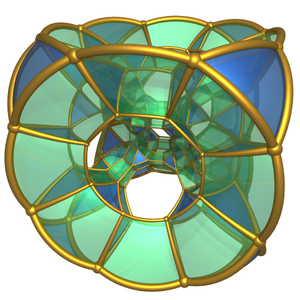
Stereographic projection
Stereographic projection
The stereographic projection, in geometry, is a particular mapping that projects a sphere onto a plane. The projection is defined on the entire sphere, except at one point — the projection point. Where it is defined, the mapping is smooth and bijective. It is conformal, meaning that it...
with its 128 blue triangular faces and its 192 green quad faces.
Runcitruncated 16-cell
| Runcitruncated 16-cell | ||
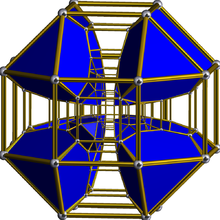  Schlegel diagrams centered on rhombicuboctahedron Rhombicuboctahedron In geometry, the rhombicuboctahedron, or small rhombicuboctahedron, is an Archimedean solid with eight triangular and eighteen square faces. There are 24 identical vertices, with one triangle and three squares meeting at each. Note that six of the squares only share vertices with the triangles... and truncated tetrahedron Truncated tetrahedron In geometry, the truncated tetrahedron is an Archimedean solid. It has 4 regular hexagonal faces, 4 regular triangular faces, 12 vertices and 18 edges.- Area and volume :... |
||
| Type | Uniform polychoron Uniform polychoron In geometry, a uniform polychoron is a polychoron or 4-polytope which is vertex-transitive and whose cells are uniform polyhedra.... |
|
| Schläfli symbol | t0,1,3{3,3,4} | |
| Coxeter-Dynkin diagram Coxeter-Dynkin diagram In geometry, a Coxeter–Dynkin diagram is a graph with numerically labeled edges representing the spatial relations between a collection of mirrors... |
||
| Cells | 80 | 8 3.4.4.4  16 3.6.6 Truncated tetrahedron In geometry, the truncated tetrahedron is an Archimedean solid. It has 4 regular hexagonal faces, 4 regular triangular faces, 12 vertices and 18 edges.- Area and volume :...  24 4.4.4 Cube In geometry, a cube is a three-dimensional solid object bounded by six square faces, facets or sides, with three meeting at each vertex. The cube can also be called a regular hexahedron and is one of the five Platonic solids. It is a special kind of square prism, of rectangular parallelepiped and...  32 4.4.6 Hexagonal prism In geometry, the hexagonal prism is a prism with hexagonal base. The shape has 8 faces, 18 edges, and 12 vertices.Since it has eight faces, it is an octahedron. However, the term octahedron is primarily used to refer to the regular octahedron, which has eight triangular faces...  |
| Faces | 368 | 64 {3} Triangle A triangle is one of the basic shapes of geometry: a polygon with three corners or vertices and three sides or edges which are line segments. A triangle with vertices A, B, and C is denoted .... 240 {4} Square (geometry) In geometry, a square is a regular quadrilateral. This means that it has four equal sides and four equal angles... 64 {6} |
| Edges | 480 | |
| Vertices | 192 | |
| Vertex figure Vertex figure In geometry a vertex figure is, broadly speaking, the figure exposed when a corner of a polyhedron or polytope is sliced off.-Definitions - theme and variations:... |
 Trapezoidal pyramid |
|
| Symmetry group Coxeter group In mathematics, a Coxeter group, named after H.S.M. Coxeter, is an abstract group that admits a formal description in terms of mirror symmetries. Indeed, the finite Coxeter groups are precisely the finite Euclidean reflection groups; the symmetry groups of regular polyhedra are an example... |
B4, [3,3,4] | |
| Properties | convex Convex polytope A convex polytope is a special case of a polytope, having the additional property that it is also a convex set of points in the n-dimensional space Rn... |
|
| Uniform index | 19 20 21 | |
The runcitruncated 16-cell (or runcicantellated tesseract) is bounded by 80 cells: 8 small rhombicuboctahedra, 16 truncated tetrahedra
Truncated tetrahedron
In geometry, the truncated tetrahedron is an Archimedean solid. It has 4 regular hexagonal faces, 4 regular triangular faces, 12 vertices and 18 edges.- Area and volume :...
, 24 cube
Cube
In geometry, a cube is a three-dimensional solid object bounded by six square faces, facets or sides, with three meeting at each vertex. The cube can also be called a regular hexahedron and is one of the five Platonic solids. It is a special kind of square prism, of rectangular parallelepiped and...
s, and 32 hexagonal prism
Hexagonal prism
In geometry, the hexagonal prism is a prism with hexagonal base. The shape has 8 faces, 18 edges, and 12 vertices.Since it has eight faces, it is an octahedron. However, the term octahedron is primarily used to refer to the regular octahedron, which has eight triangular faces...
s.
Construction
The runcitruncated 16-cell may be constructed by contracting the small rhombicuboctahedral cells of the cantellated tesseractCantellated tesseract
In four-dimensional geometry, a cantellated tesseract is a convex uniform polychoron, being a cantellation of the regular tesseract.There are four degrees of cantellations of the tesseract including with permutations truncations...
radially, and filling in the spaces between them with cubes. In the process, the octahedral cells expand into truncated tetrahedra (half of their triangular faces are expanded into hexagons by pulling apart the edges), and the triangular prisms expand into hexagonal prisms (each with its three original square faces joined, as before, to small rhombicuboctahedra, and its three new square faces joined to cubes).
The vertices of a runcitruncated 16-cell having an edge length of 2 is given by all permutations of the following Cartesian coordinates:

Structure
The small rhombicuboctahedral cells are joined via their 6 axial square faces to the cubical cells, and joined via their 12 non-axial square faces to the hexagonal prisms. The cubical cells are joined to the rhombicuboctahedra via 2 opposite faces, and joined to the hexagonal prisms via the remaining 4 faces. The hexagonal prisms are connected to the truncated tetrahedra via their hexagonal faces, and to the rhombicuboctahedra via 3 of their square faces each, and to the cubes via the other 3 square faces. The truncated tetrahedra are joined to the rhombicuboctahedra via their triangular faces, and the hexagonal prisms via their hexagonal faces.Projections
The following is the layout of the cells of the runcitruncated 16-cell under the parallel projection, small rhombicuboctahedron first, into 3-dimensional space:- The projection envelope is a great rhombicuboctahedron.
- Six of the small rhombicuboctahedra project onto the 6 octagonal faces of this envelope, and the other two project to a small rhombicuboctahedron lying at the center of this envelope.
- The 6 cuboidal volumes connecting the axial square faces of the central small rhombicuboctahedron to the center of the octagons correspond with the image of 12 of the cubical cells (each pair of the twelve share the same image).
- The remaining 12 cubical cells project onto the 12 square faces of the great rhombicuboctahedral envelope.
- The 8 volumes connecting the hexagons of the envelope to the triangular faces of the central rhombicuboctahedron are the images of the 16 truncated tetrahedra.
- The remaining 12 spaces connecting the non-axial square faces of the central small rhombicuboctahedron to the square faces of the envelope are the images of 24 of the hexagonal prisms.
- Finally, the last 8 hexagonal prisms project onto the hexagonal faces of the envelope.
This layout of cells is similar to the layout of the faces of the great rhombicuboctahedron under the projection into 2-dimensional space. Hence, the runcitruncated 16-cell may be thought of as one of the 4-dimensional analogues of the great rhombicuboctahedron. The other analogue is the omnitruncated tesseract.
Omnitruncated tesseract
| Omnitruncated tesseract | ||
 Schlegel diagram, centered on truncated cuboctahedron, truncated octahedral cells shown |
||
| Type | Uniform polychoron Uniform polychoron In geometry, a uniform polychoron is a polychoron or 4-polytope which is vertex-transitive and whose cells are uniform polyhedra.... |
|
| Schläfli symbol | t0,1,2,3{3,3,4} | |
| Coxeter-Dynkin diagram Coxeter-Dynkin diagram In geometry, a Coxeter–Dynkin diagram is a graph with numerically labeled edges representing the spatial relations between a collection of mirrors... s |
||
| Cells | 80 | 8 4.6.8 Truncated cuboctahedron In geometry, the truncated cuboctahedron is an Archimedean solid. It has 12 square faces, 8 regular hexagonal faces, 6 regular octagonal faces, 48 vertices and 72 edges...  16 4.6.6 Truncated octahedron In geometry, the truncated octahedron is an Archimedean solid. It has 14 faces , 36 edges, and 24 vertices. Since each of its faces has point symmetry the truncated octahedron is a zonohedron....  24 4.4.8 Octagonal prism In geometry, the octagonal prism is the sixth in an infinite set of prisms, formed by square sides and two regular octagon caps.If faces are all regular, it is a semiregular polyhedron.- Use :...  32 4.4.6 Hexagonal prism In geometry, the hexagonal prism is a prism with hexagonal base. The shape has 8 faces, 18 edges, and 12 vertices.Since it has eight faces, it is an octahedron. However, the term octahedron is primarily used to refer to the regular octahedron, which has eight triangular faces...  |
| Faces | 464 | 288 {4} Square (geometry) In geometry, a square is a regular quadrilateral. This means that it has four equal sides and four equal angles... 128 {6} 48 {8} |
| Edges | 768 | |
| Vertices | 384 | |
| Vertex figure Vertex figure In geometry a vertex figure is, broadly speaking, the figure exposed when a corner of a polyhedron or polytope is sliced off.-Definitions - theme and variations:... |
 Chiral scalene tetrahedron |
|
| Symmetry group Symmetry group The symmetry group of an object is the group of all isometries under which it is invariant with composition as the operation... |
[3,3,4] | |
| Properties | convex Convex polytope A convex polytope is a special case of a polytope, having the additional property that it is also a convex set of points in the n-dimensional space Rn... |
|
| Uniform index | 20 21 22 | |
The omnitruncated tesseract (or omnitruncated 16-cell) is bounded by 80 cells: 8 truncated cuboctahedra
Truncated cuboctahedron
In geometry, the truncated cuboctahedron is an Archimedean solid. It has 12 square faces, 8 regular hexagonal faces, 6 regular octagonal faces, 48 vertices and 72 edges...
, 16 truncated octahedra
Truncated octahedron
In geometry, the truncated octahedron is an Archimedean solid. It has 14 faces , 36 edges, and 24 vertices. Since each of its faces has point symmetry the truncated octahedron is a zonohedron....
, 24 octagonal prism
Octagonal prism
In geometry, the octagonal prism is the sixth in an infinite set of prisms, formed by square sides and two regular octagon caps.If faces are all regular, it is a semiregular polyhedron.- Use :...
s, and 32 hexagonal prism
Hexagonal prism
In geometry, the hexagonal prism is a prism with hexagonal base. The shape has 8 faces, 18 edges, and 12 vertices.Since it has eight faces, it is an octahedron. However, the term octahedron is primarily used to refer to the regular octahedron, which has eight triangular faces...
s.
Construction
The omnitruncated tesseract can be constructed from the cantitruncated tesseract by radially displacing the truncated cuboctahedral cells so that octagonal prisms can be inserted between their octagonal faces. As a result, the triangular prisms expand into hexagonal prisms, and the truncated tetrahedra expand into truncated octahedra.The Cartesian coordinates of the vertices of an omnitruncated tesseract having an edge length of 2 are given by all permutations of coordinates and sign of:

Structure
The truncated cuboctahedra cells are joined to the octagonal prisms via their octagonal faces, the truncated octahedra via their hexagonal faces, and the hexagonal prisms via their square faces. The octagonal prisms are joined to the hexagonal prisms and the truncated octahedra via their square faces, and the hexagonal prisms are joined to the truncated octahedra via their hexagonal faces.Projections
In the truncated cuboctahedron first parallel projection of the omnitruncated tesseract into 3 dimensions, the images of its cells are laid out as follows:- The projection envelope is in the shape of a non-uniform truncated cuboctahedron.
- Two of the truncated cuboctahedra project to the center of the projection envelope.
- The remaining 6 truncated cuboctahedra project to the (non-regular) octagonal faces of the envelope. These are connected to the central truncated cuboctahedron via 6 octagonal prisms, which are the images of the octagonal prism cells, a pair to each image.
- The 8 hexagonal faces of the envelope are the images of 8 of the hexagonal prisms.
- The remaining hexagonal prisms are projected to 12 non-regular hexagonal prism images, lying where a cube's edges would be. Each image corresponds to two cells.
- Finally, the 8 volumes between the hexagonal faces of the projection envelope and the hexagonal faces of the central truncated cuboctahedron are the images of the 16 truncated octahedra, two cells to each image.
This layout of cells in projection is similar to that of the runcitruncated 16-cell, which is analogous to the layout of faces in the octagon-first projection of the truncated cuboctahedron into 2 dimensions. Thus, the omnitruncated tesseract may be thought of as another analogue of the truncated cuboctahedron in 4 dimensions.
Images
| Perspective projections | |
|---|---|
Perspective projection centered on one of the truncated cuboctahedral Truncated cuboctahedron In geometry, the truncated cuboctahedron is an Archimedean solid. It has 12 square faces, 8 regular hexagonal faces, 6 regular octagonal faces, 48 vertices and 72 edges... cells, highlighted in yellow. Six of the surrounding octahedral prism Octahedral prism In geometry, a octahedral prism is a convex uniform polychoron . This polychoron has 10 polyhedral cells: 2 octahedra connected by 8 triangular prisms.- Related polytopes :... s rendered in blue, and the remaining cells in green. Cells obscured from 4D viewpoint culled for clarity's sake. |
Perspective projection centered on one of the truncated octahedral Truncated octahedron In geometry, the truncated octahedron is an Archimedean solid. It has 14 faces , 36 edges, and 24 vertices. Since each of its faces has point symmetry the truncated octahedron is a zonohedron.... cells, highlighted in yellow. Four of the surrounding hexagonal prism Hexagonal prism In geometry, the hexagonal prism is a prism with hexagonal base. The shape has 8 faces, 18 edges, and 12 vertices.Since it has eight faces, it is an octahedron. However, the term octahedron is primarily used to refer to the regular octahedron, which has eight triangular faces... s are shown in blue, with 4 more truncated octahedra on the other side of these prisms also shown in yellow. Cells obscured from 4D viewpoint culled for clarity's sake. Some of the other hexagonal and octagonal prisms may be discerned from this view as well. |
| Stereographic projections | |
Centered on truncated cuboctahedron |
Centered on truncated octahedron |

